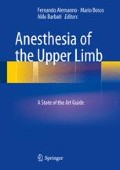Abstract
Pain is defined by the International Association for the Study of Pain (IASP) as ‘an unpleasant sensory and emotional experience primarily associated with actual or potential tissue damage or described in terms of such damage.’
Access this chapter
Tax calculation will be finalised at checkout
Purchases are for personal use only
Bibliography
Bleckner LL, Bina S, Kwon KH, McKnight G, Drogavich A, Buckenmaier CC (2010) Serum ropivacaine concentrations and systemic local anesthetic toxicity in trauma patients receiving long-term continuous peripheral nerve block catheters. Anesth Analg 110(2):630–634
Borgeat A, Aguirre J, Marquardt M, Mrdjen J, Blumenthal S (2010) Continuous interscalene analgesia with ropivacaine 0.2% versus ropivacaine 0.3% after open rotator cuff repair: the effects on postoperative analgesia and motor function. Anesth Analg 111(6):1543–1547
Borghi B, Facchini F, Agnoletti V, Adduci A, Lambertini A, Marini E et al (2006) Pain relief and motor function during continuous interscalene analgesia after open shoulder surgery: a prospective, randomized, double-blind comparison between levobupivacaine 0.25%, and ropivacaine 0.25 or 0.4%. Eur J Anaesthesiol 23(12):1005–1009
Casati A, Borghi B, Fanelli G, Montone N, Rotini R, Fraschini G et al (2003) Interscalene brachial plexus anesthesia and analgesia for open shoulder surgery: a randomized, double-blinded comparison between levobupivacaine and ropivacaine. Anesth Analg 96(1):253–259
Coluzzi F, Bragazzi L, Di Bussolo E, Pizza G, Mattia C (2011) Determinants of patient satisfaction in postoperative pain management following hand ambulatory day-surgery. Minerva Med 102(3):177–186
Dayer P, Desmeules J, Collart L (1997) Pharmacologie du tramadol. Drugs 53(Suppl. 2):18–24
Eroglu A, Uzunlar H, Sener M, Akinturk Y, Erciyes N (2004) A clinical comparison of equal concentration and volume of ropivacaine and bupivacaine for interscalene brachial plexus anesthesia and analgesia in shoulder surgery. Reg Anesth Pain Med 29(6):539–543
Fredrickson MJ, Ball CM, Dagleish AJ (2010) Analgesic effectiveness of a continuous versus single-injection interscalene block for minor arthroscopic shoulder surgery. Reg Anesth Pain Med 35(1):28–33
Fredrickson MJ, Ball CM, Dagleish AJ (2008) Successful continuous interscalene analgesia for ambulatory shoulder surgery in a private practice setting. Reg Anesth Pain Med 33(2):122–128
Fredrickson MJ, Krishnan S, Chen CY (2010) Postoperative analgesia for shoulder surgery: a critical appraisal and review of current techniques. Anesthesia 65:608–624
Grass AJ (2005) Patient controlled analgesia. Anesth Analg 101:S44–S61
Ilfeld BM, Enneking FK (2005) Continuous peripheral nerve blocks at home: a review. Anesth Analg 100:1822–1833
Ilfeld BM, Morey TE, Enneking FK (2002) Continuous infraclavicular brachial plexus block for postoperative pain control at home: a randomized, double-blinded, placebo-controlled study. Anesthesiology 96:1297–1304
Mariano ER, Afra R, Loland VJ, Sandhu NS, Bellars RH, Bishop ML et al (2009) Continuous interscalene brachial plexus block via an ultrasound-guided posterior approach: a randomized, triple-masked, placebo-controlled study. Anesth Analg 108(5):1688–1694
Mattia C, Coluzzi F, Sonnino D, Anker-Møller E (2010) Efficacy and safety of fentanyl HCl iontophoretic transdermal system compared with morphine intravenous patient-controlled analgesia for post-operative pain management for patient subgroups. Eur J Anaesthesiol 27(5):433–440
Mattia C, Coluzzi F (2009) What anesthesiologists should know about paracetamol (acetaminophen). Minerva Anestesiol 75(11):644–653
Rawal N, Allvin R, Amilon A, Ohlsson T, Hallén J (2001) Postoperative analgesia at home after ambulatory hand surgery: a controlled comparison of tramadol, metamizol, and paracetamol. Anesth Analg 92(2):347–351
Rawal N, Allvin R, Axelsson K et al (2002) Patient-controlled regional analgesia (PCRA) at home: controlled comparison between bupivacaine and ropivacaine brachial plexus analgesia. Anesthesiology 96:1290–1296
Richman JM, Liu SS, Wong R et al (2006) Does continuous peripheral nerve block provide superior pain control to opioids? A meta-analysis. Anesth Analg 102:248–257
Russon K, Sardesai AM, Ridgway S, Whitear J, Sildown D, Boswell S et al (2006) Postoperative shoulder surgery initiative (POSSI): an interim report of major shoulder surgery as a day case procedure. Br J Anaesth 97(6):869–873
Scott LJ, Perry CM (2000) Tramadol, a review of its use in perioperative pain. Drugs, 60(1):139–176
Toivonen J, Pitko VM, Rosenberg PH (2007) Etoricoxib pre-medication combined with intra-operative subacromial block for pain after arthroscopic acromioplasty. Acta Anaesthesiol Scand 51(3):316–321
Trompeter A, Camilleri G, Narang K, Hauf W, Venn R (2010) Analgesia requirements after interscalene block for shoulder arthroscopy: the 5 days following surgery. Arch Orthop Trauma Surg 130(3):417–421
Author information
Authors and Affiliations
Corresponding author
Editor information
Editors and Affiliations
Rights and permissions
Copyright information
© 2014 Springer-Verlag Italia
About this chapter
Cite this chapter
Coluzzi, F. (2014). Postoperative Analgesia. In: Alemanno, F., Bosco, M., Barbati, A. (eds) Anesthesia of the Upper Limb. Springer, Milano. https://doi.org/10.1007/978-88-470-5418-9_15
Download citation
DOI: https://doi.org/10.1007/978-88-470-5418-9_15
Published:
Publisher Name: Springer, Milano
Print ISBN: 978-88-470-5417-2
Online ISBN: 978-88-470-5418-9
eBook Packages: MedicineMedicine (R0)

